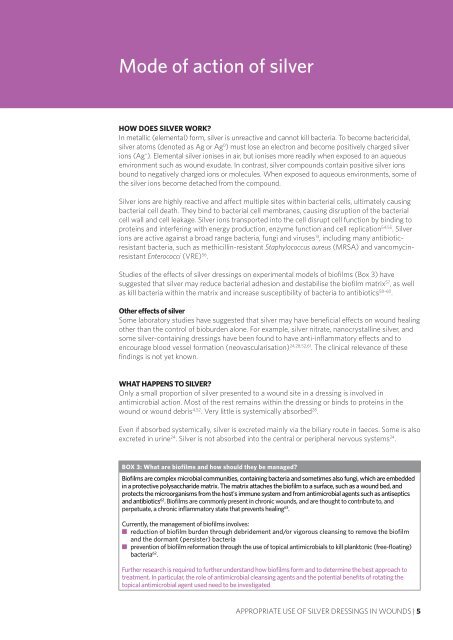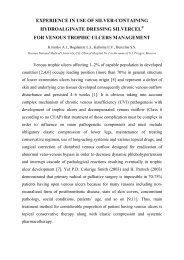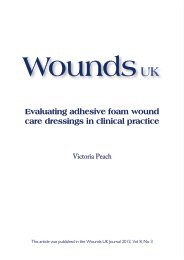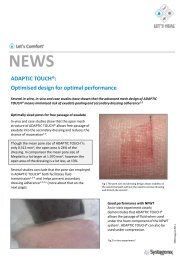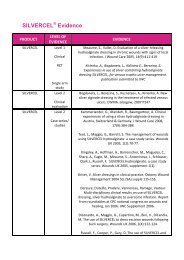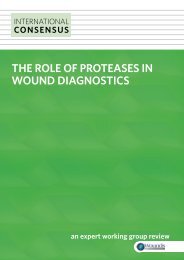appropriate use of silver dressings in wounds - Systagenix
appropriate use of silver dressings in wounds - Systagenix
appropriate use of silver dressings in wounds - Systagenix
Create successful ePaper yourself
Turn your PDF publications into a flip-book with our unique Google optimized e-Paper software.
Mode <strong>of</strong> action <strong>of</strong> <strong>silver</strong>HOW DOES SILVER WORK?In metallic (elemental) form, <strong>silver</strong> is unreactive and cannot kill bacteria. To become bactericidal,<strong>silver</strong> atoms (denoted as Ag or Ag 0 ) must lose an electron and become positively charged <strong>silver</strong>ions (Ag + ). Elemental <strong>silver</strong> ionises <strong>in</strong> air, but ionises more readily when exposed to an aqueo<strong>use</strong>nvironment such as wound exudate. In contrast, <strong>silver</strong> compounds conta<strong>in</strong> positive <strong>silver</strong> ionsbound to negatively charged ions or molecules. When exposed to aqueous environments, some <strong>of</strong>the <strong>silver</strong> ions become detached from the compound.Silver ions are highly reactive and affect multiple sites with<strong>in</strong> bacterial cells, ultimately caus<strong>in</strong>gbacterial cell death. They b<strong>in</strong>d to bacterial cell membranes, caus<strong>in</strong>g disruption <strong>of</strong> the bacterialcell wall and cell leakage. Silver ions transported <strong>in</strong>to the cell disrupt cell function by b<strong>in</strong>d<strong>in</strong>g toprote<strong>in</strong>s and <strong>in</strong>terfer<strong>in</strong>g with energy production, enzyme function and cell replication 54,55 . Silverions are active aga<strong>in</strong>st a broad range bacteria, fungi and vir<strong>use</strong>s 13 , <strong>in</strong>clud<strong>in</strong>g many antibioticresistantbacteria, such as methicill<strong>in</strong>-resistant Staphylococcus aureus (MRSA) and vancomyc<strong>in</strong>resistantEnterococci (VRE) 56 .Studies <strong>of</strong> the effects <strong>of</strong> <strong>silver</strong> <strong>dress<strong>in</strong>gs</strong> on experimental models <strong>of</strong> bi<strong>of</strong>ilms (Box 3) havesuggested that <strong>silver</strong> may reduce bacterial adhesion and destabilise the bi<strong>of</strong>ilm matrix 57 , as wellas kill bacteria with<strong>in</strong> the matrix and <strong>in</strong>crease susceptibility <strong>of</strong> bacteria to antibiotics 58–60 .Other effects <strong>of</strong> <strong>silver</strong>Some laboratory studies have suggested that <strong>silver</strong> may have beneficial effects on wound heal<strong>in</strong>gother than the control <strong>of</strong> bioburden alone. For example, <strong>silver</strong> nitrate, nanocrystall<strong>in</strong>e <strong>silver</strong>, andsome <strong>silver</strong>-conta<strong>in</strong><strong>in</strong>g <strong>dress<strong>in</strong>gs</strong> have been found to have anti-<strong>in</strong>flammatory effects and toencourage blood vessel formation (neovascularisation) 24,28,52,61 . The cl<strong>in</strong>ical relevance <strong>of</strong> thesef<strong>in</strong>d<strong>in</strong>gs is not yet known.WHAT HAPPENS TO SILVER?Only a small proportion <strong>of</strong> <strong>silver</strong> presented to a wound site <strong>in</strong> a dress<strong>in</strong>g is <strong>in</strong>volved <strong>in</strong>antimicrobial action. Most <strong>of</strong> the rest rema<strong>in</strong>s with<strong>in</strong> the dress<strong>in</strong>g or b<strong>in</strong>ds to prote<strong>in</strong>s <strong>in</strong> thewound or wound debris 4,52 . Very little is systemically absorbed 28 .Even if absorbed systemically, <strong>silver</strong> is excreted ma<strong>in</strong>ly via the biliary route <strong>in</strong> faeces. Some is alsoexcreted <strong>in</strong> ur<strong>in</strong>e 24 . Silver is not absorbed <strong>in</strong>to the central or peripheral nervous systems 24 .BOX 3: What are bi<strong>of</strong>ilms and how should they be managed?Bi<strong>of</strong>ilms are complex microbial communities, conta<strong>in</strong><strong>in</strong>g bacteria and sometimes also fungi, which are embedded<strong>in</strong> a protective polysaccharide matrix. The matrix attaches the bi<strong>of</strong>ilm to a surface, such as a wound bed, andprotects the microorganisms from the host's immune system and from antimicrobial agents such as antisepticsand antibiotics 62 . Bi<strong>of</strong>ilms are commonly present <strong>in</strong> chronic <strong>wounds</strong>, and are thought to contribute to, andperpetuate, a chronic <strong>in</strong>flammatory state that prevents heal<strong>in</strong>g 63 .Currently, the management <strong>of</strong> bi<strong>of</strong>ilms <strong>in</strong>volves:■ reduction <strong>of</strong> bi<strong>of</strong>ilm burden through debridement and/or vigorous cleans<strong>in</strong>g to remove the bi<strong>of</strong>ilmand the dormant (persister) bacteria■ prevention <strong>of</strong> bi<strong>of</strong>ilm reformation through the <strong>use</strong> <strong>of</strong> topical antimicrobials to kill planktonic (free-float<strong>in</strong>g)bacteria 62 .Further research is required to further understand how bi<strong>of</strong>ilms form and to determ<strong>in</strong>e the best approach totreatment. In particular, the role <strong>of</strong> antimicrobial cleans<strong>in</strong>g agents and the potential benefits <strong>of</strong> rotat<strong>in</strong>g thetopical antimicrobial agent <strong>use</strong>d need to be <strong>in</strong>vestigatedAPPROPRIATE USE OF SILVER DRESSINGS IN WOUNDS | 5


